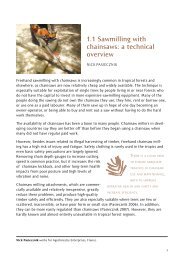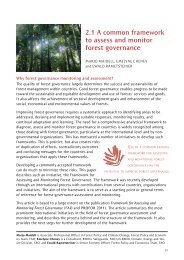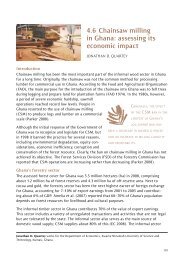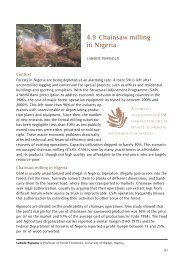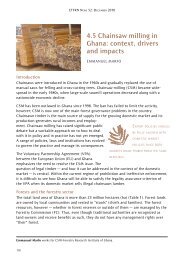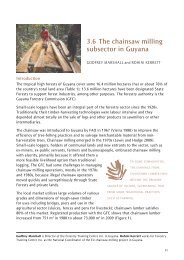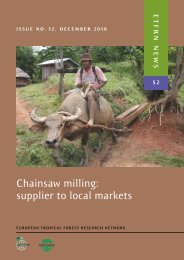Chainsaw milling: supplier to local markets - European Tropical ...
Chainsaw milling: supplier to local markets - European Tropical ...
Chainsaw milling: supplier to local markets - European Tropical ...
Create successful ePaper yourself
Turn your PDF publications into a flip-book with our unique Google optimized e-Paper software.
98<br />
ETFRN NEws 52: DEcEmbER 2010<br />
3.7 chainsaw <strong>milling</strong> in<br />
the caribbean<br />
CLAUS-MARTIN ECKELMANN, ALBERT GALLION,<br />
ANTONY SIMON, BARRY MAHABIR, ALFRED<br />
PROSPER and ALLI MORGAN<br />
introduction<br />
The islands of the Caribbean are a diverse group of countries. Following the pre-Columbian<br />
settlements of amerindians in the 16th century the islands were colonized by <strong>European</strong><br />
settlers and often changed hands between different colonial powers. most of the smaller<br />
islands were English while the larger antilles<br />
remained under spanish influence. with the<br />
exception of a few smaller islands, most of the<br />
chainsaw <strong>milling</strong> can<br />
islands are now independent states.<br />
For centuries the main income of the islands<br />
derived from agricultural production and<br />
export of agricultural commodities produced in<br />
medium- and large-scale plantations (initially sugar<br />
and later bananas). For the last 30 years, <strong>to</strong>urism<br />
has made an increasingly important contribution<br />
and is now the main source of income.<br />
if adminisTered properly<br />
play an imporTanT<br />
role in supporTing<br />
susTainable foresT managemenT in The<br />
caribbean islands and can easily be<br />
inTegraTed inTo a naTional redd+<br />
concepT.<br />
most of the island states have a forest cover of approximately 30% of the <strong>to</strong>tal land area,<br />
although there are exceptions: Dominica has more than 60% of its land area under forest<br />
and haiti has less than 5%.<br />
Forests and the forestry sec<strong>to</strong>r<br />
Throughout the insular Caribbean three main phases of forest development <strong>to</strong>ok place. in<br />
the first phase, forests were used as land reserves for agricultural production and as unregulated<br />
sources for timber. This phase started with colonization of the islands by amerindian<br />
settlers and accelerated with the arrival of the <strong>European</strong> colonists in the 16th century.<br />
The second phase was the emergence of forest management and silviculture; the first<br />
regulations <strong>to</strong> protect the forest were issued in the 17th century. as the negative impacts<br />
claus-martin eckelmann is Forestry officer for the Caribbean, Fao sub-regional office for the Caribbean,<br />
barbados; Albert Gallion is assistant Forest officer, Forest management, Forestry Department of Dominica;<br />
An<strong>to</strong>ny simon is Forestry officer, Forestry Department st. Vincent and the Grenadines; barry mahabir is<br />
assistant Conserva<strong>to</strong>r of Forests, Forestry Division of Trinidad and Tobago; Alfred Prosper is Forest officer,<br />
Forestry Department of st. lucia; and Alli morgan is Forest officer, Forestry Department of Jamaica.



